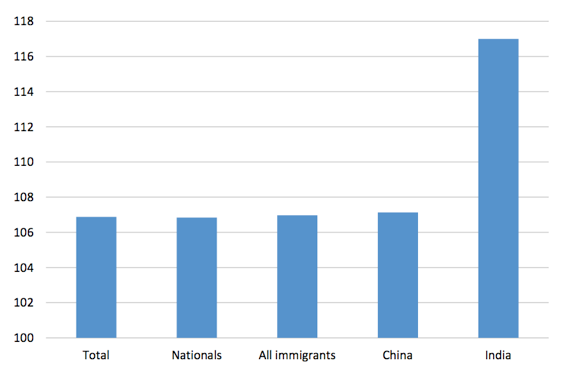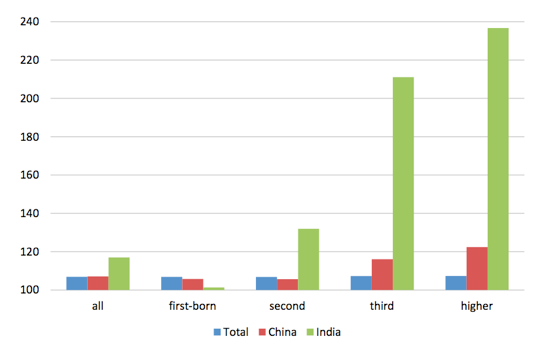When migrants enter a new country, do they bring their family planning practices with them? In her BSE Working Paper (No.760) “Missing Girls in Spain,” Libertad Gonzalez looks at birth certificate data and shows that some immigrant populations known to have son-biased birth ratios in their home country also have biased birth ratios in Spain.
What is a “missing girl”?
A “biologically normal” birth ratio is around 105 boys to 100 girls (Almond & Edlund, 2008). However, several countries (such as India and China) are known to have increasingly biased birth ratios favoring boys, creating the “missing girl” phenomenon. But does this phenomenon exist among immigrant populations from these countries?
How Do Birth Ratios Compare?
Birth certificates issued during a 6-year period, from 2007 to 2012, form the basis of the study. The first figure below shows that the average birth ratio in Spain is around 107, with natives, all immigrants, and Chinese populations roughly sharing this ratio. However, Indian migrants have a much higher birth ratio at 116 boys to 100 girls. Delving further, it is evident in the second figure that the birth ratio of Indian, as well as Chinese, migrants becomes increasing biased towards boys as the number of births in a family increases. These patterns have also been documented in India in recent decades (Jha et al. 2006).


This indicates that the phenomenon is not only present among these populations, but also that a selection mechanism is at play. It is likely that sex selective abortions are being used, as this is the only feasible method that could produce these biased ratios at birth.
So is it a boy?
Studying the birth certificate data, Gonzalez is able to work out the likelihood that a child born will be a boy. In Spain, the overall fraction of boys born is 51.7% for the study period. At 53.8% Indian migrant families have the significantly largest fraction of boys born of the studied migrant and native populations. These results are robust to specifications considering Spanish citizenship of the mother and marriage status, as well as when considering the country of origin of either parent individually.
What is striking about this group, however, are the results when birth order is considered. The likelihood that a boy is born to migrant Indian parents increases to 56.7% for a second birth, 67.7% for a third birth, and 83.7% for a fourth or higher birth. Since other parental and family controls are not significant, these results seem driven by the parent’s country of origin.
What effect did the abortion reform of 2010 have?
Effectively, none.
The reform in 2010 allowed for an abortion to be obtained with no need to provide a reason during the first 14 weeks of gestation. Previously, abortions in Spain could only be obtained during the first 12 weeks in the case of a rape, the first 22 weeks for a malformation, and anytime for therapeutic reason certified by a doctor. Using data from registered abortions Gonzalez shows that from 2000-2009, 97% of abortions reported risk to the health of the mother as a reason for termination. The most common way to comply with the therapeutic case was to have a psychologist certify that the continuation of the pregnancy would result in negative effects on the mental health of the mother.
But since the sex of a fetus is determinable at the 16th week with ultrasound (where the 20th week is more typical), or as early as week 14 with amniocentesis, it is unlikely that the reform would have an impact on sex selection as the cutoff is not during the period of sex discovery.
Looking at the data, there are no increases in the number of abortions that occur after the 16th week of gestation following the implementation of the reform. Further, when this reform is incorporated in her analysis, Gonzalez does not find that it altered her initial results, confirming that the reform did not impact the fraction of boys born. So if sex selection is driving the biased birth results, the reform did not increase its practice.
Who are these “missing girls” of Spain?
The evidence suggests that sex selection is at play in Spain among Indian (and nominally Chinese) migrant families, and that families are importing family planning practices from their home countries. The quantitative effect of this is not important in Spain, mostly because only 0.13% of all single-child births occurred to at least one Indian parent. Using her estimates Gonzalez works out that during her study period there were about 90 “missing girls” among Indian families. It is interesting that this phenomenon is happening in Spain, considering that the rationalized arguments in the literature for son-biased birth ratios in India involve institutions not present in Spain.
References
Adsera, Alicia and Ana Ferrer (2013) “Fertility Adaptation of Child Migrants to Canada”, Population Studies (forthcoming).
Almond, Douglas and Lena Edlund (2008) “Son Biased Sex Ratios in the US 2000 Census.” PNAS 105(15): 5681-5682.
Fernández, Raquel and Alessandra Fogli (2009) “Culture. An Empirical Investigation of Beliefs, Work, and Fertility” American Economic Journal: Macroeconomics 1(1): 146- 77.
Jha, Prabhat, Rahesh Kumar, Priya Vasa, Neeraj Dhingra, Deva Thiruchelvam, and Rahim Moineddin (2006) “Low female-to-male sex ratio of children born in India: National survey of 1.1 million households” Lancet 367:211-218.
Meyer, Johen and Regina Riphahn (2000) “Fertility assimilation of immigrants: Evidence from count data models” Journal of Population Economics 13: 241-261.

